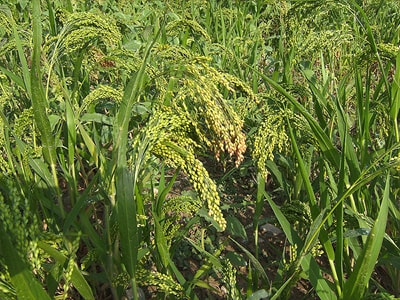Sorghum is an undeservedly neglected crop in our country. Moreover, the plant has been known for a long time, and is also widely used in agriculture in many countries.
Botanical characteristics of the plant
Sorghum is a herbaceous plant of the grass family (Poaceae). Its various species are perennial and annual, grow wild or are grown as an agricultural crop. It is heat-loving, undemanding to soil, drought-resistant and salt-resistant.
Sorghum is a fairly tall grass with a stem of half a meter or more. Some wild tropical varieties can reach up to 7 meters in height. One plant can have several stems.
The root system of sorghum is well developed and reaches 2.5 meters in depth, which allows the plant to receive moisture during the driest periods. It blooms with panicles, which can be erect or drooping, single or spreading. The length of the inflorescences reaches 70 cm or more.
The plant does not tolerate low temperatures, frosts are fatal to it at any stage. Therefore, the culture is most widespread in Asia, equatorial Africa, North and South America. In Ukraine, Russia, Moldova and Kazakhstan, sorghum is grown in southern regions that are not subject to frost during the growing period.
Different types of sorghum are used to make the following products:
- food grains;
- flour;
- starch;
- alcohol;
- animal silo;
- fuel (dry stem);
- leather paint;
- paper;
- wickerwork;
- brooms and panicles;
- roofs, fences.
Varieties of sorghum
In total, there are more than 60 species of this culture in the world, which can be combined into the following groups:
- grain;
- sugar;
- herbaceous;
- technical (broom);
- lemon.
The grain variety is similar to millet. Bread is made from this grain – in African countries it is the main grain crop. Confectionery products, cereals, flour, alcohol and starch are also produced. Sorghum grains are small, oval, of different colors – from light yellow to dark brown. Most often they are open and easy to collapse. Plants of this variety are rather short-growing and weakly bushy. The core of the stem is dry, but it produces sweet or slightly sour juice.
Sweet sorghum is used to produce molasses, a sweet syrup used in confectionery production. Only the stems are used, the core of which, unlike other varieties, always remains juicy and sweet, and not dry. The plants are tall and bushy. The grains are difficult to collapse, they are usually filmy.
The herbaceous species is mowed at the growth stage, and it produces excellent green mass for livestock feed. Moreover, the plant grows very quickly after mowing. Under favorable conditions, proper irrigation and compliance with deadlines, up to 3-4 cuttings can be made per season.
Technical or broom sorghum produces first-class straw. It is used to make paper and various wickerwork – from handicrafts to roofs and fences. The main advantage of this species is the panicles of various types, widely used in everyday life. The most common product of this type is an ordinary household broom, well known to all housewives. Very often, hard-to-collapse grains remain on these brooms.
The lemon variety is used in cooking. It makes an excellent seasoning for a variety of cuisines: fish, meat, vegetables. This seasoning goes especially well with seafood. It also produces excellent essential oils used in perfumery and medicine.
Nutritional value of sorghum crop
Unfortunately, this culture is not widespread in the CIS countries, so it is practically unknown to many consumers. It is grown in the southern, warm regions of Russia, Ukraine and Kazakhstan, but, as a rule, for technical purposes (only a small part is used for food).
But at the same time, sorghum has excellent nutritional characteristics and high energy value. In countries of traditional cultivation, especially in Africa, this crop occupies a place similar to our wheat. It is used to bake bread, various confectionery products, and also make baby food.
The grains of this unique crop contain the necessary elements for a healthy diet:
- proteins;
- fiber;
- fats;
- carbohydrates;
- ash;
- ascorbic acid;
- folic acid;
- biotin;
- niacin;
- riboflavin;
- thiamine.
Also present are microelements necessary for health – potassium, zinc, selenium, magnesium, iron and others. The energy value is about 340 kcal. Sorghum dishes are very nutritious – even small portions can saturate the body without overloading it with a large amount of food. Eating porridge from this plant helps improve brain function and the cardiovascular system.
Grains contain many antioxidants that cleanse and protect the body. Dishes made from them speed up the body’s metabolic processes. They increase hemoglobin production, cleanse the skin, and are useful for the gastrointestinal tract and for restoring the nervous system.
Sorghum fruits also contain phosphorus, an extremely important element for the formation of the skeleton and strengthening bone tissue. Phosphoric acid helps in building a variety of enzymes necessary for cell reactions.
For diabetics, sorghum dishes are a real salvation – they regulate sugar levels and also take part in the synthesis of glucose. The substances contained in these products not only stimulate the production of hemoglobin, but also transport oxygen into the body by red blood cells.
Sorghum biofuel
Recently, the issue of replacing conventional fuel sources with alternative ones has become very acute. Petroleum products are becoming more expensive, their reserves are decreasing, and they also heavily pollute the atmosphere and harm people’s health. At the moment, biological fuel cannot completely replace petroleum products, but its development is being carried out at an accelerated pace, and every year the production of biofuels is becoming more accessible, profitable and beneficial for the environment.
In addition, such fuel provides such an important aspect, especially for the rapidly developing energy sector, as energy security or energy independence. Biofuel production can be organized within the country without attracting imports. It is an always available and renewable source.
Not least in these developments, along with sugar cane and corn, is biofuel from sorghum. For this purpose, its sugar varieties are used, from which a large amount of ethanol is obtained – the basis for biofuel.
Modern technologies make it possible to improve existing varieties of this crop in order to expand its growing area, as well as adapt it to initially unsuitable conditions. For example, scientists from the University of Florida have proposed genetically modified varieties that are resistant to pests and diseases. Work is also underway to obtain cold-resistant varieties.
Thus, it will be possible to grow sorghum not only in the south of Kazakhstan, Russia, Ukraine, but also in other, more northern regions, occupying large areas and producing more environmentally friendly biofuel.< /p>






























